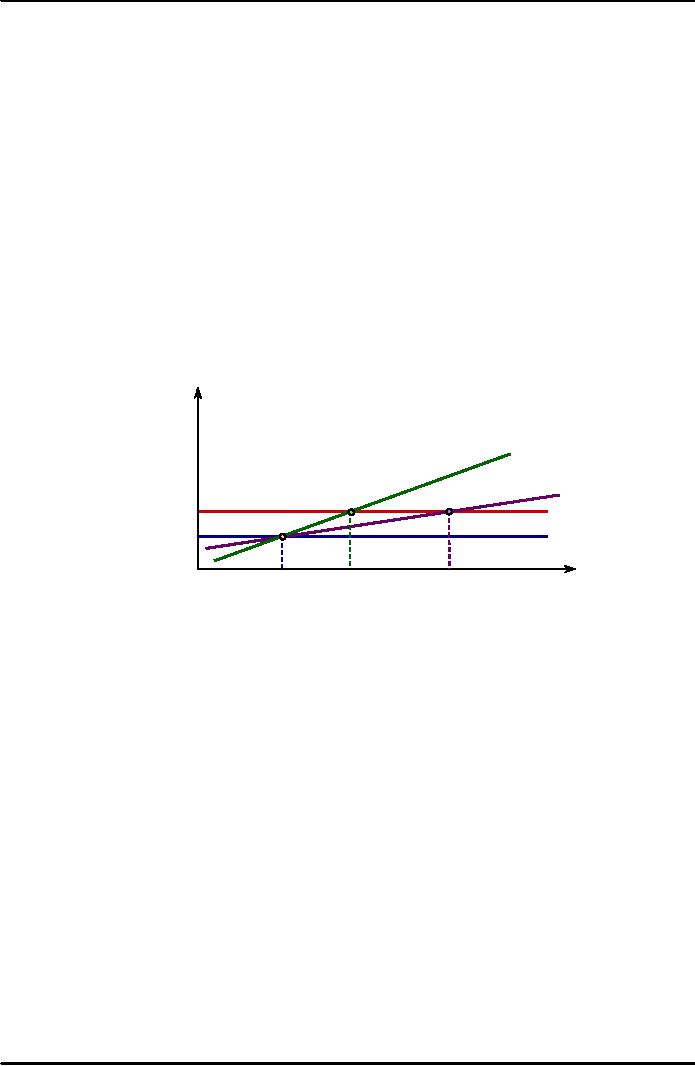 |

Introduction
to Economics ECO401
VU
Lesson
10.3
MACROECONOMIC
EQUILIBRIUM & VARIABLES; THE
DETERMINATION OF
EQUILIBRIUM
INCOME (CONTINUED...........)
THE
KEYNESIAN MULTIPLIER AND
ACCELERATOR
The
Keynesian Multiplier:
Reverting
to the 450 line
approach, the term
[1/(1-b)]
is
called the Keynesian
multiplier ("k")
and
is the factor by which
equilibrium output, income or
expenditure increase in response
to
an
increase in AD (caused by an increase in
"a", G, I or X-M). The
higher is b, the bigger is
the
multiplier.
Mathematical
representation of Keynes multiplier is as
follows:
Y
= C + I + G + NX
As
C
= a + bY
Then,
Y
= a + bY + I + G + NX
Y
bY = a + I + G + NX
Y
= a + I + G + NX = 1 (a + I + G + NX)
1b
1b
k=
1____
1b
Keynes's
intuition about the
multiplier was as follows:
An
increase in AD caused by an injection
into the circular flow,
e.g. higher
government
spending
on wages paid to government
employees, would lead to
higher money wages
held
by
government servants. Higher
wages would translate into
higher consumption
expenditure
on
goods and services in the
economy, leading to higher
money incomes of sellers of
goods
and
services. When firms see
consumers more prosperous,
they are incentivised to
produce
more,
thus their demand for
labour goes up. This
triggers a second rise of
income increases in
the
hands of workers (who are
also consumers) leading to a
further multiplied effect
on
consumption,
production and hiring. And so
on. The multiplier effect
would not be infinite
as
there
are leakages (saving, taxes,
imports) from the circular
flow of incomes each time
the
workers
receive wages from firms.
The lower the leakages
and the higher the
marginal
propensity
to consume, the higher will
be the multiplier
effect.
Keynes
paradox of Thrift:
The
reverse multiplier effect
can be illustrated in the
context of Keynes's paradox of
thrift,
which
highlights the negative
impact of higher saving in an
economy in recession. As
noted
earlier,
Classical economists thought
the solution to the problem
of low investment during
the
Great
Depression was high real
interest rates caused by low
savings. If the latter could
be
increased,
the real interest rate
would fall and investment
would pick up. However,
Keynes
said
that such thrift (or
conservative saving behaviour)
would accentuate the
recession. As
people
save more, they will
spend less. Firms will
therefore produce less, and
labour hiring
will,
as a result, fall, leading to a
decline in incomes. This
decline would also happen in
a
multiplied
fashion, causing a huge
decline in national income.
The paradox lies in the
fact that
that
saving, while usually
considered good for any
one individual, can actually
be harmful to
the
overall economy if everyone
started saving.
The
Accelerator:
The
accelerator is a related concept
which formalizes the
investment response to output
or
income
changes in an economy. The
key observation here is that
when an economy begins
to
recover
from a slump, investment can
rise very rapidly and, in
percentage terms, the rise
in
investment
may be several times the
rise in income. Since
investment is an injection into
the
100

Introduction
to Economics ECO401
VU
circular
flow of income, these
changes in investment will
cause multiplied changes in
income
and
thus heighten a boom or
deepen a recession. The
formula for the accelerator
is α
=
I/(ΔY),
or
(ΔK)/(ΔY),
noting that I = ΔK, where I is
investment and K is capital
(the stock of plants,
buildings
or machinery in the
economy).
The
reason why investment increases by
much more than a change in
income is as
follows:
Suppose
firms anticipate national
income (and hence the
demand for their products)
to rise by
10%
p.a. over the next 5
years. In response, firms
will therefore normally look
to undertake an
investment
(such as buying a machine)
which will enable them to
meet this new demand
for
the
entire 5 year period. It is
usually neither feasible nor
possible to buy a machine
that has a
one
year life! Thus, it is easy
to see why a given annual
change in output (10%) might
prompt
firms
with a five year horizon to
make an investment of over
50%.
Reverting
back to the formula, the
size of the accelerator, α,
depends on the marginal
capital
to
output ratio: (ΔK)/(ΔY).
This is the cost of extra
capital required to produce a
Re.1 increase
in
national output. So if Rs.2
billion worth of capital is
required to produce Rs.1
billion worth of
output,
then (ΔK)/(ΔY)
is 2. It is easy to see that,
other things being equal
the marginal capital-
output
ratio and the accelerator
are essentially the same.
α
is
likely to be greater than
1.
Interaction
of accelerator and
Multiplier:
It
is obvious that the
interaction of the accelerator
and multiplier can set
off a chain reaction
in
the
economy which can life
output and income manifold.
For e.g., if there is a rise
in
government
expenditure, this will lead
to a multiplied rise in national
income. But this rise
in
national
income will set off an
accelerator effect: firms
will respond to the rise in
incomes (and
the
resulting rise in consumer
demand) by investing more.
But this rise in investment
will
constitute
a further rise in injections
and thus will lead to a
second multiplies rise in
income.
And
so on...
The
reason why such an
interaction cannot raise
output infinitely is because of
two reasons i)
the
economy runs into the
full-employment constraint, i.e.
there is a fixed number of
workers in
the
economy, and ii) output
must grow at an increasing
rate (something which is
difficult to
sustain
for very long) in order
for investment to continue
rising. This is because the
accelerator
links
investment to changes in output,
not the level of output. So
for e.g., if output rises in
year
1
by Rs.3bn, in year 2 by Rs.2bn,
and in year 3 by Rs.1bn,
then with α
= 2,
investment will be
Rs.6bn,
Rs.4bn, and Rs.2bn in years
1, 2 and 3 respectively. As can be
seen, I falls even
though
output is rising, leading to a
reverse multiplier accelerator
chain reaction to be set
off
effect
will be reversed. The key
point to remember, again, is
that investment is related
to
"changes
in income" not the "level of
income", and therefore
"changes in income" have
to
increase
in order for investment to
increase. A mere increase in
level is not
important.
101

Introduction
to Economics ECO401
VU
END
OF UNIT 10 - EXERCISES
What
are the conditions for
macroeconomic equilibrium in the
economy.
i.
Injections (governemnt spending,
exports, investment) into
the circular flow of
incomes
must equal the withdrawals
(saving, taxes, imports)
from the circular
flow;
or
ii.
Aggregate demand must equal
aggregate income must equal
aggregate supply.
The
two approaches are
equivalent. Note, however,
that the equilibrium of an
economy, at least
in
a Keynesian world, does not
imply the full-employment
equilibrium. It is possible
for
inflationary
and deflationary gaps to
exist.
What
are the major macroeconomic
variables involved in the
determination of national
income?
C,
I, G, X, M, T, S, prices, exchange rate,
interest rate and money
supply. We focus on the
first
seven
in this part of the course,
but will enrich our
analysis with the remaining
four later in the
context
of the IS-LM approach to
equilibrium determination and
international finance
considerations.
What
does the 45 degree line in
expenditure-income space
represent?
It
represents all the points at
which the economy is in
equilibrium, i.e. the
expenditure on
domestic
goods and services is equal
to the supply of domestic
goods and services is equal
to
the
incomes distributed to factors
used in the production of
those goods and
services
Are
the following net
injections, net withdrawals or
neither? If there is
uncertainty,
explain
your assumptions.
i.
Firms spend money on
research.
ii.
The government increases
personal tax
allowances.
iii.
The general public deposits
more money in
banks.
iv.
Pakistani investors earn
higher dividends on overseas
investments.
v.
The government purchases US
military aircraft.
vi.
People draw on their savings
to finance holiday trips
abroad.
vii.
People draw on their savings
to finance holidays within
Pakistan.
viii.The
government runs a budget
deficit (spends more than it
receives in tax
revenues)
and finances it by borrowing
from the general
public.
ix.
The government runs a budget
deficit and finances it by
printing more
money.
i.
Increase
in injections (investment).
ii.
Decrease
in withdrawals (taxes).
iii.
Increase
in withdrawals (saving).
iv.
Fall
in withdrawals (a reduction in net
outflow abroad from the
household sector).
v.
Neither.
The inner flow is
unaffected. If, however,
this were financed from
higher
taxes,
it would result in an increase in
withdrawals.
vi.
Neither. The inner flow is
unaffected. The consumption of
domestically produced
goods
and services remains the
same.
vii.
Decrease in withdrawals
(saving).
viii.
Neither. An increase in government
expenditure (or decrease in
taxes, or both) is
offset
by an increase in saving (i.e.
people buying government
securities).
ix.
Net injections. An increase in
government expenditure (or
decrease in taxes, or
both)
is not offset by changes
elsewhere. Extra money is
printed to finance the
net
injection.
102

Introduction
to Economics ECO401
VU
It
is possible that as people
get richer they will
spend a smaller and smaller
fraction of
each
rise in income (and save a
larger fraction). Why might
this be so? What effect
will it
have
on the shape of the
consumption function?
It
is likely that the rich
will feel that they
can afford to save a larger
proportion of their
income
than
the poor. The consumption
function will slope upwards,
but get less and
less steep. This
means
mpc will fall as incomes
rise.
What
effect will the following
have on the mpc:
a)
a rise in the rate of income
tax;
b)
people anticipate that the
rate of inflation is about to
rise;
c)
the government redistributes
income from the rich to
the poor?
a)
The mpc will fall.
Note that here we are
relating consumption to gross
income. For any
given
gross income, a rise in
taxes will cause a fall in
disposable income and hence
a fall
in
consumption.
b)
The mpc will rise as
people spend a larger
fraction of any rise in
income, for if they
wait
to
consume, their incomes will
be worth less in the enxt
period in urchasing power
terms.
c)
The mpc will increase,
because the poor have a
higher mpc than the
rich.
What
would be the impact of
changing the determinant
variables given in the first
column
(below)
on consumption and saving.
Must saving always fall if
consumption falls?
Determinant
Consumption
Saving
Income
(rise)
rise
rise
Assets
held (increase in)
rise
fall
Taxation
(fall)
rise
rise
Cost
of credit (lower interest
rates)
rise
fall
Expectations
(that prices will
rise)
rise
fall
Redistribution
of income (becomes more
equal)
rise
fall
Tastes
and attitudes (people want
to consume more)
rise
fall
The
average age of durables
(increases)
rise
fall
Thus
there are two determinants
of consumption (namely income
and taxation, which will
not
cause
saving to rise if consumption is
caused to fall.
Why,
if the growth in output
slows down (but is still
positive), is investment likely to
fall
(i.e.
be negative)?
Because
firms will require a smaller
increase in capital. They
will thus buy fewer
extra machines
and
other equipment: i.e.
investment will fall. The
underlying concept is that of
Keynes's
investment
accelerator which relates
induced investment to changes in
output rather than
the
level
of output.
103

Introduction
to Economics ECO401
VU
Give
some other examples of
changes in one injection or
withdrawal that can
affect
others.
·
A
rise in government expenditure on
infrastructure projects may
encourage firms to
invest,
or,
on the other hand, may
replace private
investment.
·
A
rise in taxation will reduce
savings and imports as well
as consumption of domestic
goods
and services.
·
A
depreciation of the exchange
rate will lead to increased
exports (an injection)
and
decreased
imports (a withdrawal). This
could encourage increased
investment in the
domestic
economy.
·
Higher
savings will mean less
total consumption, including
less expenditure on
imports.
Keeping
Keynes's paradox of thrift
arguments in mind, is an increase in
saving ever
desirable?
Yes.
·
If
there is a problem of excess
demand, an increase in savings
will reduce
inflationary
pressures.
·
If
investment increases over
time, an increase in savings
will allow these increases
to be
financed
without problems of rising
interest rates or inflation,
problems which would
have
the
effect of curtailing the
investment.
The
present level of a country's
exports is £12 billion;
investment is £2 billion;
government
expenditure is £4 billion; total
consumer spending (including on
imports) is
£36
billion; imports are £12
billion and expenditure
taxes are £2 billion. The
economy is
currently
in equilibrium. It is estimated that an
income of £50 billion is
necessary to
generate
full employment. The
marginal propensity to save is
0.25.
a)
Is there an inflationary or deflationary
gap in this
situation?
b)
What is the size of the
gap? (Don't confuse
this with the
difference
between
Ye and
Yf.)
c)
What would be an appropriate
government policy to close
this gap?
Injections
(J) = £12bn + £2bn + £4bn =
£18bn
Domestic
consumption (Cd)
= £36bn £12bn £2bn =
£22bn
∴
Expenditure on
domestic goods, E = Cd +
J = £18 + £22 = £40bn
Multiplier
= 1/mps = 1/0.25
=4
a)
Deflationary gap. If the
economy is in equilibrium, then Y = E.
Thus Ye =
£40bn. But full
employment
is achieved at an income of £50bn.
There is thus a deflationary
gap.
b)
£2.5bn. This is the amount
that must be injected (given
a multiplier of 4) in order to
increase
national income by £10bn
from the current £40bn to
the full-employment level
of
£50bn.
c)
Increase government expenditure by
£2.5bn.
Why
does investment in construction
and producer goods
industries tend to
fluctuate
more
than investment in retailing
and the service
industries?
Because
demand for the output of
these industries (which are
`investment' goods
industries)
fluctuates
much more as a result of the
accelerator effect.
Give
some examples of single
shocks and continuing
changes on the demand
side.
Does
the existence of multiplier
and accelerator effects make
the distinction
between
single
shocks and continuing
effects more difficult to
make on the demand side
than on
the
supply side?
Examples
of single shocks include
government expenditure on a specific
project, a surge in
consumer
spending in anticipation of a rise in
taxes and a temporary
movement in the
exchange
104

Introduction
to Economics ECO401
VU
rate
(a depreciation causing a rise in
aggregate demand through
increased exports and
decreased
imports, and an appreciation
causing a fall in aggregate
demand). Examples of
continuing
changes include a sustained
increase in consumer or business
confidence, which
builds
over time, and changes in
interest rates that then
remain for a period of time.
The
multiplier
and accelerator will amplify
single shocks on the demand
side and the process
will last
for
several months. Aggregate
demand will not go on and on
rising, however, unless
there are
continuing
changes on the demand side,
which then continue to be
amplified by the
multiplier
and
accelerator. Thus the
effects are somewhat less
clear cut than with
changes on the supply
side,
but it is still possible to
distinguish between single
shocks on the demand side
and
continuing
changes (even if the single
shocks do cause multiplier
and accelerator
effects).
Draw
an injections and withdrawals
diagram, with a fairly
shallow W curve. Mark
the
equilibrium
level of national income.
Now draw a second steeper W
curve passing
through
the same point. This
second W curve would
correspond to the case where
the
mps
is higher.
Assuming
now that there has
been an increase in injections,
draw a second J line above
the
first.
Mark the new equilibrium
level of national income
with each of the two W
curves. You can
see
that national income rises
less with the steeper W
curve. The higher mps
has a
W,
J
Weconomy
2
Weconomy
1
J2
J1
O
Y0
Y2
Y1
Y
Economies
with different marginal
rates of taxation
dampening
effect on the multiplier. A
higher tax rate has
the same dampening effect as
well by
reducing
the size of the multiplier
(by increasing the size of
the term in the
denominator).
Multiplier
with taxes = 1/[1-{mpc(1-t)}];as t
increases, (1-t) falls,,
therefore 1-{.} rises,
causing
the
multiplier to fall.
What
effects will government
investment expenditure have on
public-sector debt (a)
in
the
short run; (b) in the
long run?
a)
Increase. Unless financed by
extra taxation, an increase in
government expenditure
(for
whatever
purpose) will lead to an
increase in public-sector
debt.
b)
Possibly decrease. If the
investment leads to extra
output and income, then
the extra tax
revenue
from the extra incomes
and expenditure could more
than offset the cost of
the
investment,
thereby leading to a fall in
public-sector debt.
If
cuts in interest rates are
not successful in causing
significant increases in
investment,
how can they lead to
economic recovery? What, in
these circumstances,
determines
the magnitude of the
recovery?
They
can lead to recovery if they
cause consumers to borrow
more. The increased
spending
causes
a multiplied rise in national
income. The magnitude of the
recovery depends on (a)
the
amount
of extra consumer spending;
(b) the size of the
multiplier; (c) whether
there is any
subsequent
increase in investment (through
the accelerator
effect).
105

Introduction
to Economics ECO401
VU
How
do people's expectations influence
the outcome?
People's
expectations will reinforce
whatever it is they expect
(self-fulfilling expectations). If
firms
expect a rise in government
expenditure to lead to a) higher
interest rates, b) a reduction
in
private-sector
investment and hence c) no
expansion of the economy,
they will reduce
their
investment
plans, thus bringing about
the effect (i.e. economic
stagnation) that they
had
anticipated.
If
the government increases
spending by Rs.10bn and
finances it totally from
taxes, will
there
be any expansionary impact on
output?
Yes.
The increase in spending is an
injection of Rs.10 bn. The
withdrawal, however, is less
than
Rs.10bn,
as saving (a withdrawal from
the system falls). Why
does saving fall? Because
higher
taxes
reduce disposable income and
therefore given a fixed mps
out of disposable
income,
saving
will fall. The concept is
called balanced budget
multiplier, i.e. the fact
that tax-financed
spending
(which has no effect on the
fiscal balance) can still be
expected to have a
multiplied
(albeit
much smaller) effect on
equilibrium output and
income.
106
Table of Contents:
- INTRODUCTION TO ECONOMICS:Economic Systems
- INTRODUCTION TO ECONOMICS (CONTINUED………):Opportunity Cost
- DEMAND, SUPPLY AND EQUILIBRIUM:Goods Market and Factors Market
- DEMAND, SUPPLY AND EQUILIBRIUM (CONTINUED……..)
- DEMAND, SUPPLY AND EQUILIBRIUM (CONTINUED……..):Equilibrium
- ELASTICITIES:Price Elasticity of Demand, Point Elasticity, Arc Elasticity
- ELASTICITIES (CONTINUED………….):Total revenue and Elasticity
- ELASTICITIES (CONTINUED………….):Short Run and Long Run, Incidence of Taxation
- BACKGROUND TO DEMAND/CONSUMPTION:CONSUMER BEHAVIOR
- BACKGROUND TO DEMAND/CONSUMPTION (CONTINUED…………….)
- BACKGROUND TO DEMAND/CONSUMPTION (CONTINUED…………….)The Indifference Curve Approach
- BACKGROUND TO DEMAND/CONSUMPTION (CONTINUED…………….):Normal Goods and Giffen Good
- BACKGROUND TO SUPPLY/COSTS:PRODUCTIVE THEORY
- BACKGROUND TO SUPPLY/COSTS (CONTINUED…………..):The Scale of Production
- BACKGROUND TO SUPPLY/COSTS (CONTINUED…………..):Isoquant
- BACKGROUND TO SUPPLY/COSTS (CONTINUED…………..):COSTS
- BACKGROUND TO SUPPLY/COSTS (CONTINUED…………..):REVENUES
- BACKGROUND TO SUPPLY/COSTS (CONTINUED…………..):PROFIT MAXIMISATION
- MARKET STRUCTURES:PERFECT COMPETITION, Allocative efficiency
- MARKET STRUCTURES (CONTINUED………..):MONOPOLY
- MARKET STRUCTURES (CONTINUED………..):PRICE DISCRIMINATION
- MARKET STRUCTURES (CONTINUED………..):OLIGOPOLY
- SELECTED ISSUES IN MICROECONOMICS:WELFARE ECONOMICS
- SELECTED ISSUES IN MICROECONOMICS (CONTINUED……………)
- INTRODUCTION TO MACROECONOMICS:Price Level and its Effects:
- INTRODUCTION TO MACROECONOMICS (CONTINUED………..)
- INTRODUCTION TO MACROECONOMICS (CONTINUED………..):The Monetarist School
- THE USE OF MACROECONOMIC DATA, AND THE DEFINITION AND ACCOUNTING OF NATIONAL INCOME
- THE USE OF MACROECONOMIC DATA, AND THE DEFINITION AND ACCOUNTING OF NATIONAL INCOME (CONTINUED……………..)
- MACROECONOMIC EQUILIBRIUM & VARIABLES; THE DETERMINATION OF EQUILIBRIUM INCOME
- MACROECONOMIC EQUILIBRIUM & VARIABLES; THE DETERMINATION OF EQUILIBRIUM INCOME (CONTINUED………..)
- MACROECONOMIC EQUILIBRIUM & VARIABLES; THE DETERMINATION OF EQUILIBRIUM INCOME (CONTINUED………..):The Accelerator
- THE FOUR BIG MACROECONOMIC ISSUES AND THEIR INTER-RELATIONSHIPS
- THE FOUR BIG MACROECONOMIC ISSUES AND THEIR INTER-RELATIONSHIPS (CONTINUED…….)
- THE FOUR BIG MACROECONOMIC ISSUES AND THEIR INTER-RELATIONSHIPS (CONTINUED…….):Causes of Inflation
- THE FOUR BIG MACROECONOMIC ISSUES AND THEIR INTER-RELATIONSHIPS (CONTINUED…….):BALANCE OF PAYMENTS
- THE FOUR BIG MACROECONOMIC ISSUES AND THEIR INTER-RELATIONSHIPS (CONTINUED…….):GROWTH
- THE FOUR BIG MACROECONOMIC ISSUES AND THEIR INTER-RELATIONSHIPS (CONTINUED…….):Land
- THE FOUR BIG MACROECONOMIC ISSUES AND THEIR INTER-RELATIONSHIPS (CONTINUED…….):Growth-inflation
- FISCAL POLICY AND TAXATION:Budget Deficit, Budget Surplus and Balanced Budget
- MONEY, CENTRAL BANKING AND MONETARY POLICY
- MONEY, CENTRAL BANKING AND MONETARY POLICY (CONTINUED…….)
- JOINT EQUILIBRIUM IN THE MONEY AND GOODS MARKETS: THE IS-LM FRAMEWORK
- AN INTRODUCTION TO INTERNATIONAL TRADE AND FINANCE
- PROBLEMS OF LOWER INCOME COUNTRIES:Poverty trap theories: